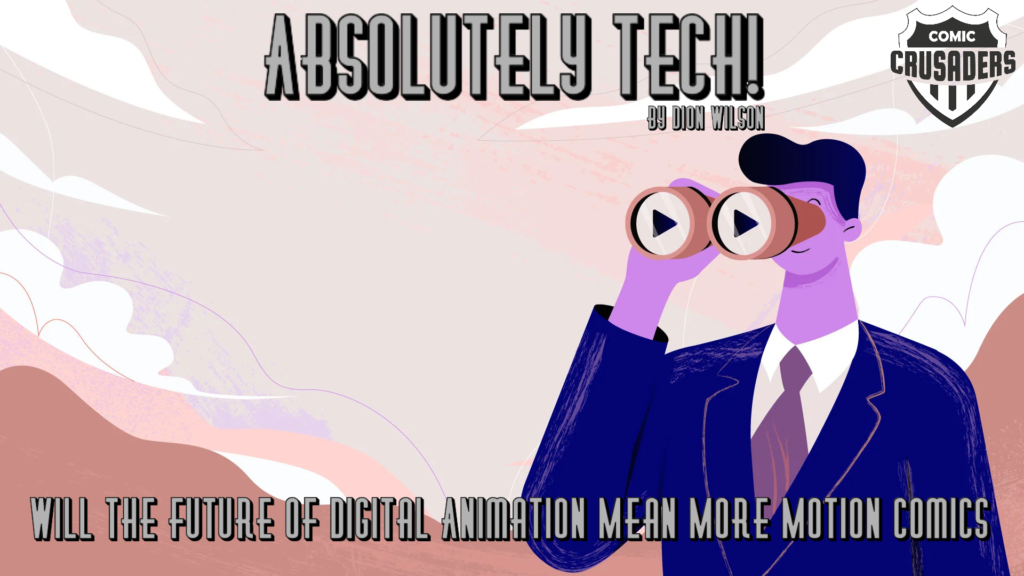
Will the Future of Digital Animation Mean More Motion Comics?
The Motion Comic evolved out of a product called an animatic. Animatics have been used by movie producers to show studios heads and production crews how a scene in a live action film will take place. Overtime these inexpensive and quick production tools have become direct to consumer products smaller content creators use to tell their comic stories. Not anywhere close in cost to produce as a full featured movie, motion comics allow fans to get just enough movement, story and sound to feel they are experiencing something more akin to an animated film than a static comic book.
“The physical limitations of the printed page are lifted as computer screens offer virtually unlimited space to arrange comics panels.” – Joseph Batinic, Digital Comics: Harder, Better, Faster, Stronger?
Fast forward to today and sites like YouTube literally have hundreds of motion comic stories created by channel owners. Just as big a part of the comic fandom as regular readers, these creatives use voice actors, sound and visual effects to recreate some of comics most popular stories.
It is in no small way the motion comic owes its invention to animation; and while these budget friendly storytelling tools whet comic fans appetites for their favorite characters and stories to get new visual treatment, animation continues to reach unprecedented heights of visual storytelling quality. For the US, the journey of illustration into motion began in the early 1900s with the stop motion film The Enchanted Drawing. As the journey continues well into the 2000s, we experience cutting edge digital animation today. Computers with powerful processors, Mo-Cap (motion-capture) and CGI (computer-generated imagery) assist artists and film makers to create photo-realistic images and fluid movement on screen. These visuals constantly challenge the human eye to believe what it sees as real. Also aiding visual emersion for the consumer are 4K and 8K high definition screens. Soon artificial intelligence and virtual reality tools will join forces and take visual and tactile emerson to even farther boundaries of realism.
Now that the reader has been presented some historical context for how we got where we are with motion comics and digital animation, premissed with the fact that animation has directly contributed to motion comic’s utility. Let’s come back to the title and question: Will the future of digital animation mean more motion comics? The short answer, definitely. But let’s explore some of the ways this process will likely take place.
Tools which create animated films will become less expensive as more advanced ones are developed, adopted and become the preferred standard of production. The financial barrier to entry on new tools will cause some motion comic creators who lack the budget to obtain older, less expensive versions. Next, due to feature additions in each version, even lower cost and older version tools will bring with them additional abilities to enhance even the most common motion comic. Each “hand me down” animation production toolset brings with it a new way to tell the story. Imagine what turn the motion comic will take when an entire Mo-Cap set is for sale on Amazon for as little as $199.99?*
Creatives who innovate unique animation and design processes will also enhance the storytelling effect. Thereby influencing other creators to experiment with the same or come up with a new style in their motion comic products. The more viewers who are drawn to consume these projects, the more likely new projects will be started. That is to say, consumer demand will also further drive new motion comic output.
If the consumer’s fascination with motion comics was just about moving static comic book pages to full blown animation, viewers would likely bypass these unique storytelling devices and plunge directly into fully animated films. But I suspect there is another experience objective here. From a psychological standpoint viewers of motion comics still want to achieve a connected and visibly identifiable relationship with the comic book. Therefore, talk balloons, panels and some static visuals will remain in these mediums, albeit enhanced versions. In an animated film, keeping these devices specifically for reading becomes redundant and difficult on viewers.
Currently digital comic sales largely comprise of static digital versions which mirror their print counterparts. There is room and opportunity within the market to sell more motion comics and make them the new “go to” for digital sales. Including opportunities for companies to create unique desktop platforms and mobile apps to focus on selling and allowing these comics to play. I would be remiss in failing to mention how the consumer can have more than sight and sound enhancement when engaging a motion comic. Opportunities exist to include the viewer-reader in the storytelling process. From making on screen choices, to purchasing associated merchandise, winning collectibles, and providing voice or physical jesture. All of these and some not mentioned, can make the motion comic explode as, “the next big thing.”
Finally, as creators put more emphasis on motion comics, use a combination of the ideas above or any others and focus on story types consumers are most interested in, demand could skyrocket. Advancements in animation will bring more and more features to motion comic books which will put them one step ahead of where they have been. These improvements are likely to remain balanced so they remain recognizable as a form of digital comic book.
*Note: Individual Mo-Cap accessories are definitely for sale on Amazon and have various price ranges. The purpose of the above question was to get the reader to think about the fact that what was high end movie production tools years ago, are now more accessible and less experience today.
References:
Digital Comics: Harder, Better, Faster, Stronger?
https://networkcultures.org/longform/2016/11/21/digital-comics-harder-better-faster-stronger/
Impact of digital media on comics, Author Ozge Samanci
https://dl.acm.org/doi/10.1145/2619195.2656299
The Evolution of Animation – a Timeline
https://www.fudgeanimation.com/2018/11/the-evolution-of-animation-a-timeline/







